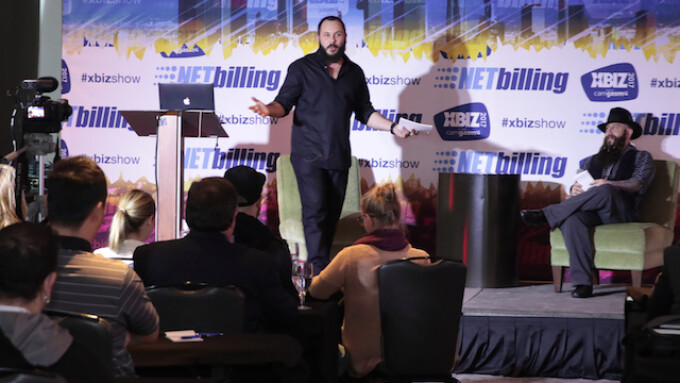LOS ANGELES — On Jan. 11, the Andaz Hotel’s Panorama Ballroom was packed with XBIZ 2017 attendees eager to hear the Digital Media Keynote address from speaker Greg Lansky, chief creative officer of Blacked.com, Tushy.com and Vixen.com, and one of adult’s biggest recent success stories.
Alejandro Freixes, XBIZ Associate Managing Editor, Digital Media, introduced Lansky as the man who single-handedly brought about a “porn renaissance.” He “defied conventional wisdom” with his savvy business maneuvers, “treating adult films and performance as an art form” — and at a time when the adult industry was thought to be in its death throes due to piracy and free online product.
Lansky wryly declared he would “try to wing it” and then spoke at eloquent length about the business of porn and his own rise to the top. “It was three years ago — I can really remember the beginning, in the most demoralized market ever,” that he and his wife started Blacked.com and Tushy.com. Two years later, Vixen.com arrived.
He now has 70 employees on two continents and his sites get 20 million unique visitors per month, with his DVD spinoffs distributed by Jules Jordan Video.
“We focused on a superior quality of adult film,” Lansky said. He was undeterred by naysayers who “thought we were crazy spending that much money on content.”
He gave credit to the “fierce loyalty” of his customers, quoting one in particular who said of the product: “I feel like I should have paid for that. I don’t feel robbed.”
“We trusted the market,” he said, and it responded to “our style, our covers and marketing.”
“Art is close to my heart,” he continued. “Adult performers are artists. Art is when you do the best work you can do, when you feel alive.”
He quoted a celebrated critic who decreed that there are two kinds of art, Fine Art and Industrial Art. The latter includes movies, fashion, DJing — to which he would add sex performance. “There is nothing more vulnerable than being naked and performing in front of millions of people.”
He objects to porn being called “outside the mainstream... The system is operated to keep us in a box, to create shame around us... Creativity challenges the status quo.”
Responding to the moderator’s question about the best manner in which to disseminate ideas and brand awareness, Lansky showed a visual slide of sliced bread, which originally was not considered all that great. “No matter how great you are, if you don’t know how to get your ideas to spread,” you will not go far, he noted.
He showed some often hilarious slides of ads for bizarre sex sites to demonstrate that “customers have way too many choices and too little time.”
Lansky said his aim is to make his movies “remarkable — that is, worth remarking about. That is the key to every brand we’ve created... Being ‘very good’ is boring. You’ve got to be ‘remarkable.’”
He mentioned the success of Tesla, which created a remarkable product from what was originally perceived as a lame concept, the electric car. “It’s a matter of perception... We created a brand that was beautiful, we changed the perception of what porn is.”
He brought up the Japanese word “otaku,” meaning something that is “more than a hobby but a little less than an obsession,” and advised, “You want to find that audience — people on the edge, people that care... You want to talk to the early adopters and innovators... Find something worth evolving — something on the fringes — and build a successful company on it.”
Commenting on a question about social media’s impact on the creative process, especially in regards to balancing brand consistency with adaptability, Lansky said that reading one negative tweet would make him “think about it for the rest of the day.” His advice is, “Just ignore the people who don’t get it. You don’t need everybody to succeed. Your art is not for everyone.
“The kind of art that works is not made for the masses. It’s the people on the edge you want to talk to.” He used the Harry Potter phenomenon as an example of niche art that went on to be accepted by a mass audience.
Lansky’s personal creed is, “Don’t be boring. Don’t be safe. Find the balance between boring and ridiculous.” He added, “There’s a huge amount of value in failure. Fail. Learn. Repeat.”
In response to the moderator noting his support for performers, he counseled them on “being vulnerable, resisting shame, ignoring people who don’t get it.... Pushing shame is one of the most powerful tools. Once you feel it you stop creating. You’ve got to be shameless. You have to be vulnerable to create something of value.... You can refuse shame.”
He left the full house enthralled with this maxim: “Figure out who your art is for and get better at connecting with that audience. If you’re not reaching your audience, make better art. Keep doing it until your art gets better.”
To watch the Digital Media Keynote in its entirety, click here.








